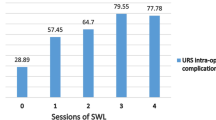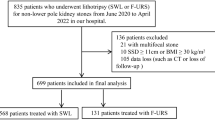Abstract
This study aims to evaluate the outcome of ureteroscopy/ureterorenoscopy (URS) as a salvage procedure for stones resistant to extracorporeal shock wave lithotripsy (ESWL). Between January 2009 and January 2012, 313 patients with upper tract lithiasis were treated by URS. Among them, 87 (27.8 %) had undergone URS after prior ESWL failed to achieve stone clearance (Salvage group). These patients were matched with a group of patients who underwent URS as first-line modality (Primary group). Stone-free rates and adjuvant procedures represented the primary points for comparison. Secondary points for comparison included complications, procedure duration, total laser energy used and length of hospitalization. Matching was possible in all cases. Stone clearance rates were 73.6 and 82.8 % for the Salvage and Primary group, respectively. The difference in stone clearance rates between the two groups was not statistically significant (p = 0.186). A total of 11 patients (12.6 %) in the Primary group and 18 patients (20.7 %) in the Salvage group underwent an adjuvant procedure (p = 0.154). No statistically significant differences were noted in terms of complications, procedure duration and length of hospitalization. In the Primary group, the laser energy used for stone fragmentation was higher (p = 0.043). The rate of ureteric stenting at the end of the procedure was higher for the Salvage group (p = 0.030). Previous failed ESWL is not a predictor for unfavorable outcome of URS. Salvage URS is associated, however, with an increased need for ureteric stenting at the end of the procedure.

Similar content being viewed by others
References
Preminger GM, Tiselius HG, Assimos DG et al (2007) Guideline for the management of ureteral calculi. Eur Urol 52:1610–1631
Wang AJ, Preminger GM (2011) Modern applications of ureteroscopy for intrarenal stone disease. Curr Opin Urol 21:141–144
El-Nahas AR, El-Assmy AM, Mansour O, Sheir KZ (2007) A prospective multivariate analysis of factors predicting stone disintegration by extracorporeal shock wave lithotripsy: the value of high-resolution noncontrast computed tomography. Eur Urol 51:1688–1693
Gomha MA, Sheir KZ, Showky S, Abdel-Khalek M, Mokhtar AA, Madbouly K (2004) Can we improve the prediction of stone-free status after extracorporeal shock wave lithotripsy for ureteral stones? A neural network or a statistical model? J Urol 172:175–179
Delakas D, Karyotis I, Daskalopoulos G, Lianos E, Mavromanolakis E (2003) Independent predictors of failure of shockwave lithotripsy for ureteral stones employing a second-generation lithotripter. J Endourol 17:201–205
Kanao K, Nakashima J, Nakagawa K et al (2006) Preoperative nomograms for predicting stone-free rate after extracorporeal shock wave lithotripsy. J Urol 176:1453–1456
Hussain M, Acher P, Penev B, Cynk M (2011) Redefining the limits of flexible ureterorenoscopy. J Endourol 25:45–49
Leijte JA, Oddens JR, Lock TM (2008) Holmium laser lithotripsy for ureteral calculi: predictive factors for complications and success. J Endourol 22:257–260
Perlmutter AE, Talug C, Tarry WF, Zaslau S, Mohseni H, Kandzari SJ (2008) Impact of stone location on success rates of endoscopic lithotripsy for nephrolithiasis. Urology 71:214–217
Stav K, Cooper A, Zisman A, Leibovici D, Lindner A, Siegel YI (2003) Retrograde intrarenal lithotripsy outcome after failure of shock wave lithotripsy. J Urol 170:2198–2201
Jung H, Nørby B, Osther PJ (2006) Retrograde intrarenal stone surgery for extracorporeal shock-wave lithotripsy-resistant kidney stones. Scand J Urol Nephrol 40:380–384
Holland R, Margel D, Livne PM, Lask DM, Lifshitz DA (2006) Retrograde intrarenal surgery as second-line therapy yields a lower success rate. J Endourol 20:556–559
Tugcu V, Gürbüz G, Aras B, Gurkan L, Otunctemur A, Tasci AI (2006) Primary ureteroscopy for distal-ureteral stones compared with ureteroscopy after failed extracorporeal lithotripsy. J Endourol 20:1025–1029
Fernandez De la Maza S, Noldus J, Huland H (1999) Ureterorenoscopy (URS) in treatment of ureteral calculi. I. Safety and effectiveness of URS as auxiliary treatment after ESWL. Urologe A 38:128–132
Pearle MS, Calhoun EA, Curhan GC, Urologic Diseases of America Project (2005) Urologic diseases in America project: urolithiasis. J Urol 173:848–857
Turney BW, Reynard JM, Noble JG, Keoghane SR (2011) Trends in urological stone disease. BJU Int. doi:10.1111/j.1464-410X.2011.10495.x (Epub ahead of print)
Resorlu B, Oguz U, Resorlu EB, Oztuna D, Unsal A (2011) The impact of pelvicaliceal anatomy on the success of retrograde intrarenal surgery in patients with lower pole renal stones. Urology 79:61–66 (Epub ahead of print)
Lim SH, Jeong BC, Seo SI, Jeon SS, Han DH (2010) Treatment outcomes of retrograde intrarenal surgery for renal stones and predictive factors of stone-free. Korean J Urol 51:777–782
El-Nahas AR, El-Tabey NA, Eraky I et al (2009) Semirigid ureteroscopy for ureteral stones: a multivariate analysis of unfavorable results. J Urol 181:1158–1162
Fuganti PE, Pires S, Branco R, Porto J (2008) Predictive factors for intraoperative complications in semirigid ureteroscopy: analysis of 1235 ballistic ureterolithotripsies. Urology 72:770–774
Elashry OM, Elgamasy AK, Sabaa MA et al (2008) Ureteroscopic management of lower ureteric calculi: a 15-year single-centre experience. BJU Int 102:1010–1017
Grasso M, Ficazzola M (1999) Retrograde ureteropyeloscopy for lower pole caliceal calculi. J Urol 162:1904–1908
Menezes P, Dickinson A, Timoney AG (1999) Flexible ureterorenoscopy for the treatment of refractory upper urinary tract stones. BJU Int 84:257–260
Grasso M, Loisides P, Beaghler M, Bagley D (1995) The case for primary endoscopic management of upper urinary tract calculi: I. A critical review of 121 extracorporeal shock-wave lithotripsy failures. Urology 45:363–371
Sofer M, Watterson JD, Wollin TA, Nott L, Razvi H, Denstedt JD (2002) Holmium:YAG laser lithotripsy for upper urinary tract calculi in 598 patients. J Urol 167:31–34
Jiang H, Wu Z, Ding Q, Zhang Y (2007) Ureteroscopic treatment of ureteral calculi with holmium:YAG laser lithotripsy. J Endourol 21:151–154
Chaussy CG, Fuchs GJ (1989) Current state and future developments of noninvasive treatment of human urinary stones with extracorporeal shock wave lithotripsy. J Urol 141:782–789
Manohar T, Ganpule A, Desai M (2008) Comparative evaluation of Swiss LithoClast 2 and holmium:YAG laser lithotripsy for impacted upper-ureteral stones. J Endourol 22:443–446
Raman JD, Pearle MS (2008) Management options for lower pole renal calculi. Curr Opin Urol 18:214–219
Yuruk E, Tefekli A, Sari E et al (2009) Does previous extracorporeal shock wave lithotripsy affect the performance and outcome of percutaneous nephrolithotomy? J Urol 181:663–667
Grasso M, Liu JB, Goldberg B, Bagley DH (1995) Submucosal calculi: endoscopic and intraluminal sonographic diagnosis and treatment options. J Urol 153:1384–1389
Knudsen BE, Pedro R, Hinck B, Monga M (2011) Durability of reusable holmium:YAG laser fibers: a multicenter study. J Urol 185:160–163
Conflict of interest
The authors declare that they have no conflict of interest.
Author information
Authors and Affiliations
Corresponding author
Rights and permissions
About this article
Cite this article
Philippou, P., Payne, D., Davenport, K. et al. Does previous failed ESWL have a negative impact of on the outcome of ureterorenoscopy? A matched pair analysis. Urolithiasis 41, 531–538 (2013). https://doi.org/10.1007/s00240-013-0603-6
Received:
Accepted:
Published:
Issue Date:
DOI: https://doi.org/10.1007/s00240-013-0603-6




